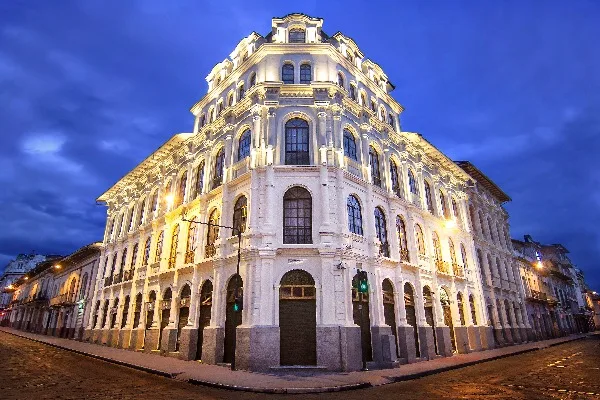SYLVAN HARDYChecking out Cuenca’s ‘gringo invasion’ and other popular myths in the land of the blind
When a friend told me recently that there are 4,000 gringos living permanently in Cuenca, I asked where he got his information.
“I read it in a blog,” he said.
“Who’s blog?” I asked.

“I don’t remember,” he answered.
My friend had more alarming news to share: gringos are driving up real estate prices in Cuenca.
“Did you read this on the same blog?” I asked.
“No,” he said. “I heard this in person, last Friday night, at a bar on Calle Borrero.”
“So this is from a reliable source?” I pressed my point.
“Well, I just met the guy but he seemed to know what he was talking about,” he said.
“Was liquor being served?” I asked.
“Yes,” he said. “It was a bar and it was happy hour.”
Because I was curious about the claims being made –I had heard similar ones myself– I asked my friend if he would help me get the real story (my old newspaper editor instinct to delegate kicks in easily). He accepted the assignment.
First, we contacted a faculty member at the University of Cuenca who is directing graduate students in a project to determine the number of foreign residents living in Cuenca as well as the number of tourists who visit each year. Second, we talked to an official with the immigration office in Quito. Third, we contacted the U.S. State Department.
On the claim that gringos are driving real estate prices higher, we talked to a manager at the local land registry office and to an officer with the Cuenca association of real estate agents.
Before we could come up with meaningful numbers we had to define gringo and I accepted my friend’s definition that, for our purposes, gringos are North Americans, Brits (throwing in Australians and New Zealanders for good measure) and northern Europeans.
This is what we found.
There are between 800 and 900 registered censo ID card holders in Cuenca. In addition, there are 750 cedulas registered to foreign residents in the canton. Our sources at immigration cautioned that these numbers are incomplete and probably paint an inaccurate picture of the number of resident gringos. The number of censos and cedulas recorded on local and national lists lag weeks, and sometimes months, behind actual registrations, they say. Besides, they have no way of knowing for sure how many censo and cedula card holders have left the Cuenca area or, who have left the country entirely.
The U.S. State Department said that their numbers, too, could not provide much guidance in determining the permanent expat population. After checking with the U.S. Consulate in Guayaquil, the State Department rep in Washington, D.C., reported that 3,240 U.S. citizens had registered with the consulate in the last five years. The problem, he said, was that the numbers are for the entire southern region of Ecuador and, because they cover a five-year period, many of those registered are no longer in the country. Adding to the confusion, the rep said, is the fact that only about 50% of citizens living outside the U.S. ever bother to register with embassies and consulates anyway. We consulted the U.S. numbers, by the way, because we believe 85% to 90% of gringo residents are U.S. citizens.
The University of Cuenca grad students say that there are about 2,000 gringos living in Cuenca. Of these, they say, 600 to 700 are permanent residents while the rest are students, teachers, missionaries, volunteers in social projects and long-term tourists on temporary visas.
Our conclusion: we agree with the grad students that there are 600 to 700 gringo residents in Cuenca.
The students, by the way, report that the number of gringos has risen rapidly since the end of 2008, when they estimate it stood at 450 to 500. They attribute the growth to publicity appearing in such publications and websites as Lonely Planet, International Living, National Geographic, Luxury Latin America and MSN Money, which have ranked Cuenca as a top destination for tourism and retirement.
Probably the most interesting fact to come out of the grad students' study is that there are more than 2,000 Colombians living in Cuenca. They are refugees from the guerrilla war in Colombia and live here legally.
Are gringos driving up local real estate prices?
Our sources at the land registry office and the real estate agents association estimate that there are between 10 and 12 property sales to gringos in Cuenca each month. This number represents less than half of 1% of all local sales. All concerned say that sales to gringos are increasing – there were seven or eight per month in 2008 – but that they are still a minor factor in the market.
The driving force in local sales, say our sources, are Ecuadorians who live overseas, primarily in the U.S. and Spain, or those who are returning home to live. This group is buying real estate at a record pace. On a per capita basis, Ecuador has the highest number of its citizens living out of the country of any Latin American country, 3 to 3.5 million out of a population of 14 million. Ecuadorians living out of the country or, who were returning to Ecuador, were responsible for 35% of all local sales in 2008, according to the realtors, and 30% in 2009. Real estate prices in Cuenca appreciated at a rate of 8% to 9% in 2009, the highest of any city in Ecuador.
Our conclusion: gringos have little if any affect on real estate prices in Cuenca.
My friend says he will share the facts at the next gringo happy hour. Cheers.
Sylvan Hardy, former Southeast Asia editor for the Manchester Guardian, vacillates between Ecuador and other flights of fancy. He can be reached at sylvanhardy@gmail.com.





















